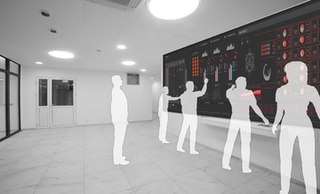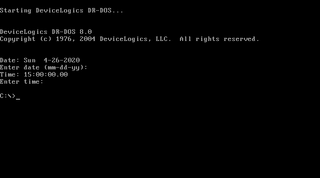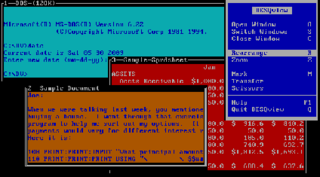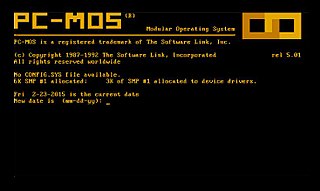Related Research Articles

Multi-user software is computer software that allows access by multiple users of a computer. Time-sharing systems are multi-user systems. Most batch processing systems for mainframe computers may also be considered "multi-user", to avoid leaving the CPU idle while it waits for I/O operations to complete. However, the term "multitasking" is more common in this context.

DR-DOS is a disk operating system for IBM PC compatibles. Upon its introduction in 1988, it was the first DOS that attempted to be compatible with IBM PC DOS and MS-DOS.
Real mode, also called real address mode, is an operating mode of all x86-compatible CPUs. The mode gets its name from the fact that addresses in real mode always correspond to real locations in memory. Real mode is characterized by a 20-bit segmented memory address space and unlimited direct software access to all addressable memory, I/O addresses and peripheral hardware. Real mode provides no support for memory protection, multitasking, or code privilege levels.

DESQview (DV) is a text mode multitasking operating environment developed by Quarterdeck Office Systems which enjoyed modest popularity in the late 1980s and early 1990s. Running on top of DOS, it allows users to run multiple programs concurrently in multiple windows.
In computing, the DOS Protected Mode Interface (DPMI) is a specification introduced in 1989 which allows a DOS program to run in protected mode, giving access to many features of the new PC processors of the time not available in real mode. It was initially developed by Microsoft for Windows 3.0, although Microsoft later turned control of the specification over to an industry committee with open membership. Almost all modern DOS extenders are based on DPMI and allow DOS programs to address all memory available in the PC and to run in protected mode.

In DOS memory management, expanded memory is a system of bank switching that provided additional memory to DOS programs beyond the limit of conventional memory (640 KiB).

In DOS memory management, conventional memory, also called base memory, is the first 640 kilobytes of the memory on IBM PC or compatible systems. It is the read-write memory directly addressable by the processor for use by the operating system and application programs. As memory prices rapidly declined, this design decision became a limitation in the use of large memory capacities until the introduction of operating systems and processors that made it irrelevant.

TopView is the first object-oriented, multitasking, and windowing, personal computer operating environment for PC DOS developed by IBM, announced in August 1984 and shipped in March 1985. TopView provided a text-mode operating environment that allowed users to run more than one application at the same time on a PC. IBM demonstrated an early version of the product to key customers before making it generally available, around the time they shipped their new PC AT computer.
In the 80386 microprocessor and later, virtual 8086 mode allows the execution of real mode applications that are incapable of running directly in protected mode while the processor is running a protected mode operating system. It is a hardware virtualization technique that allowed multiple 8086 processors to be emulated by the 386 chip. It emerged from the painful experiences with the 80286 protected mode, which by itself was not suitable to run concurrent real-mode applications well. John Crawford developed the Virtual Mode bit at the register set, paving the way to this environment.
Virtual DOS machines (VDM) refer to a technology that allows running 16-bit/32-bit DOS and 16-bit Windows programs when there is already another operating system running and controlling the hardware.

Multiuser DOS is a real-time multi-user multi-tasking operating system for IBM PC-compatible microcomputers.
A DOS extender is a computer software program running under DOS that enables software to run in a protected mode environment even though the host operating system is only capable of operating in real mode.

PC-MOS/386 is a multi-user, multitasking computer operating system produced by The Software Link (TSL), announced at COMDEX in November 1986 for February 1987 release. PC-MOS/386, a successor to PC-MOS, can run many MS-DOS programs on the host machine or a terminal connected to it. Unlike MS-DOS, PC-MOS/386 is optimized for the Intel 80386 processor; however early versions will run on any x86 computer. PC-MOS/386 used to be proprietary, but it was released as open-source software in 2017.

Oracle VM VirtualBox is a hosted hypervisor for x86 virtualization developed by Oracle Corporation. VirtualBox was originally created by InnoTek Systemberatung GmbH, which was acquired by Sun Microsystems in 2008, which was in turn acquired by Oracle in 2010.
FlexOS is a discontinued modular real-time multiuser multitasking operating system (RTOS) designed for computer-integrated manufacturing, laboratory, retail and financial markets. Developed by Digital Research's Flexible Automation Business Unit in Monterey, California, in 1985, the system was considered to become a successor of Digital Research's earlier Concurrent DOS, but with a new, modular, and considerably different system architecture and portability across several processor families. Still named Concurrent DOS 68K and Concurrent DOS 286, it was renamed into FlexOS on 1 October 1986 to better differentiate the target audiences. FlexOS was licensed by several OEMs who selected it as the basis for their own operating systems like 4680 OS, 4690 OS, S5-DOS/MT and others. Unrelated to FlexOS, the original Concurrent DOS system architecture found a continuation in successors like Concurrent DOS XM and Concurrent DOS 386 as well.
In computing, the Virtual Control Program Interface (VCPI) is a specification published in 1989 by Phar Lap Software that allows a DOS program to run in protected mode, granting access to many features of the processor not available in real mode. It was supplanted by DOS Protected Mode Interface (DPMI) shortly after being introduced, due in large part to VCPI's inability to work in Windows 3.0's protected mode.

Windows 3.0 is the third major release of Microsoft Windows, launched in 1990. Its new graphical user interface (GUI) represents applications as clickable icons, instead of the list of file names in its predecessors. Later updates expand capabilities, such as multimedia support for sound recording and playback, and support for CD-ROMs.

MS-DOS 4.0 was a multitasking release of MS-DOS developed by Microsoft based on MS-DOS 2.0. Lack of interest from OEMs, particularly IBM, led to it being released only in a scaled-back form. It is sometimes referred to as European MS-DOS 4.0, as it was primarily used there. It should not be confused with PC DOS 4.00 or MS-DOS 4.01 and later, which did not contain the multi-tasking features.
The Multiuser DOS Federation (MDOS) was an industry alliance to promote the growth and acceptance of multi-user DOS-based solutions on 286, 386 and 486 computers. It was formed in July 1990. Initially among them were Digital Research, Theos Software, SunRiver, DigiBoard, Alloy, Viewport International and others. The idea was to reduce costs by allowing workgroups to run DOS applications from a shared PC while working on terminals or workstations.
References
- ↑ "Release 1.0: IBM's Next Generation: From PC to System" (PDF). Edventure Holdings Inc. 1987-04-06.
- ↑ "Of Interest". Dr. Dobb's . 1988-06-01.
- 1 2 3 4 Tamm, Rüdiger (1991). "VM/386: Der Ferrari-Motor für den Trabbi". In Wurthmann, Gerold; Wopperer, Bernhard; Wiesböck, Johann (eds.). Vorträge und Begleittexte zum 2. Entwicklerforum der Design & Elektronik zum Thema: PC-Architektur, 17. September 1991, München[Presentations and supplemental material for the second developer forum on PC architecture on 17 September 1991, Munich] (book) (in German) (1 ed.). Munich, Germany: Markt & Technik Verlag Aktiengesellschaft. p. 205. (NB. The forum was organized by the German magazine Design & Elektronik and Intel.)
- 1 2 3 4 Tamm, Rüdiger (March 1990). "VM/386: Der Ferrari-Motor für den Trabbi". Design & Elektronik - die Spezialzeitschrift für Hard- und Softwareentwickler (in German). Markt & Technik.
- ↑ Clement Shammas, Namir (July 1988). "VM/386: A Virtual Solution". BYTE . pp. 155–158. Retrieved 2020-08-24.
- 1 2 Miller, Michael J.; Capen, Tracey (1989-02-13). "Multitasking". InfoWorld : 57–58.
- ↑ Wurthmann, Gerold; Wopperer, Bernhard; Wiesböck, Johann (1991). "Die DPMI-Spezifikation – Eine Einführung – Appendix B: DPMI Hosts" [An introduction to the DPMI specification – appendix B: DPMI hosts]. In Wurthmann, Gerold; Wopperer, Bernhard; Wiesböck, Johann (eds.). Vorträge und Begleittexte zum 2. Entwicklerforum der Design & Elektronik zum Thema: PC-Architektur, 17. September 1991, München[Presentations and supplemental material for the second developer forum on PC architecture on 17 September 1991, Munich] (book) (in German) (1 ed.). Munich, Germany: Markt & Technik Verlag Aktiengesellschaft. pp. 223, 239. (NB. The forum was organized by the German magazine Design & Elektronik and Intel.)
- ↑ "Alternativen zu MS-DOS auf der Rollbahn: Alle sind schneller als Microsoft". Computerwoche (in German). 1987-02-06.
- ↑ Bright, David (1987-06-22). "Softguard unloads VM/386". Computerworld . XXI (25): 33.
Citing a drain on its resources Softguard Systems, Inc. recently announced that it has agreed to transfer the rights to its VM/386 virtual machine operating system project to Intelligent Graphics Corp., also in Santa Clara.
- ↑ "VM/386". Archived from the original on 2013-06-06.
- ↑ "The 5th Annual Awards (1988): 386 Software Technology". PC Magazine .
- ↑ "Finally: Multi-user DOS". InfoWorld (ad). 1989-03-27.
- ↑ "VM/386 Technical Specifications". Archived from the original on 2012-03-24.
- ↑ Everex Systems Inc. announces DOS multitasker for UNIX workstations, 1989-10-23
- ↑ "MRE Consulting Group, Inc. - Solving Business Problems Since 1978".